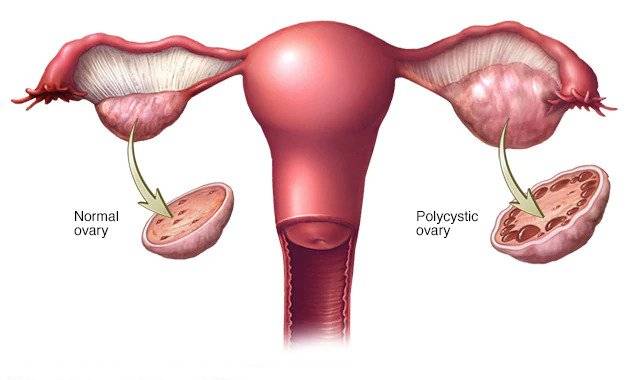PCOS (Polycystic Ovary Syndrome)
PCOS is a complex hormonal condition in which the ovaries produce an abnormal amount of androgens, male sex hormones that are usually present in women in small amounts. PCOS describes the numerous small cysts (fluid-filled sacs) that form in the ovaries. However, some women with this disorder do not have cysts, while some women without the disorder do develop cysts.
Ovulation occurs when a mature egg is released from an ovary. This happens so it can be fertilized by a male sperm. If the egg is not fertilized, it is sent out of the body during your period.
In some cases, a woman doesn’t make enough of the hormones needed to ovulate. When ovulation doesn’t happen, the ovaries can develop many small cysts. These cysts make hormones called androgens. Women with PCOS often have high levels of androgens. This can cause more problems with a woman’s menstrual cycle. And it can cause many of the symptoms of PCOS.
For comprehensive and personalized care, consider consulting the Best Dr for PCOS Treatment in Mumbai | Dr Anshumala Shukla Kulkarni, who can help manage your symptoms and improve your quality of life.

Symptoms:
The symptoms of PCOS may include:
Missed periods, irregular periods, or very light periods
Ovaries that are large or have many cysts
Excess body hair, including the chest, stomach, and back (hirsutism)
Weight gain, especially around the belly (abdomen)
Acne or oily skin
Male-pattern baldness or thinning hair
Infertility
Small pieces of excess skin on the neck or armpits (skin tags)
Dark or thick skin patches on the back of the neck, in the armpits, and under the breasts
Cause of PCOS:
The cause of PCOS is unknown, but it is thought this happens because increased levels of insulin affect how the ovaries work. You are more likely to develop PCOS if you have a close family member with the condition, there were increased hormones while you were in the womb, or due to your lifestyle or environment.
Immediate female relatives (daughters or sisters) of women with PCOS have as much as a 1 in 2 chance of having PCOS. Type 2 diabetes is also common in families of those with PCOS.
Prevalence:
Polycystic ovarian syndrome is believed to be one of the most common hormonal abnormalities found in women. Depending on the criteria used to define the syndrome, PCOS may affect between 5 and 10% of women of reproductive age.
The presence of polycystic ovaries alone is not enough to achieve a diagnosis of PCOS. This is because multiple ovarian cysts are detected in as many as 20-25% of normal women on ultrasound examination.
PCOS is a very common hormone problem for women of childbearing age.
Diagnosis:
You will be asked about your medical history and your symptoms. You may have a pelvic exam. This exam checks the health of your reproductive organs, both inside and outside your body.
Your doctor will talk to you to try to understand your symptoms. You may be asked to have:
Blood tests – to check hormone (such as testosterone), cholesterol and glucose levels in the blood
Ultrasound scan – to look at the ovaries and check for the presence of multiple cysts (fluid-filled sacs)
Treatment:
Treatment for PCOS depends your age, how severe your symptoms are, whether you want to become pregnant in the future and your overall health.
If you do plan to become pregnant, your treatment may include:
A change in diet and activity – A healthy diet and more physical activity can help you lose weight and reduce your symptoms. They can also help your body use insulin more efficiently, lower blood glucose levels, and may help you ovulate.
Medications to cause ovulation – Medications can help the ovaries to release eggs normally. These medications also have certain risks. They can increase the chance for a multiple birth (twins or more). And they can cause ovarian hyper stimulation. This is when the ovaries release too many hormones. It can cause symptoms such as abdominal bloating and pelvic pain.
If you do not plan to become pregnant, your treatment may include:
Birth control pills – These help to control menstrual cycles, lower androgen levels, and reduce acne.
Diabetes medication – This is often used to lower insulin resistance in PCOS. It may also help reduce androgen levels, slow hair growth, and help you ovulate more regularly.
A change in diet and activity – A healthy diet and more physical activity can help you lose weight and reduce your symptoms. They can also help your body use insulin more efficiently, lower blood glucose levels, and may help you ovulate.
Medications to treat other symptoms – Some medications can help reduce hair growth or acne.
